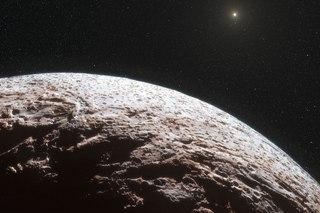
Artist's impression of the surface of the dwarf planet Makemake. Photo: European Southern Observatory.
LONDON (PTI): Astronomers have discovered that a distant dwarf planet, about two thirds the size of Pluto, lacks atmosphere.
The planet 'Makemake' travels around the Sun in a distant path that lies beyond that of Pluto but closer to the Sun than Eris, the most massive known dwarf planet in the Solar System.
Previous observations of chilly Makemake have shown it to be similar to its fellow dwarf planets, leading some astronomers to expect its atmosphere, if present, to be similar to that of Pluto.
But astronomers led by Jose Luis Ortiz (Instituto de Astrofisica de Andalucia, CSIC, Spain) in a new study have found that like Eris, Makemake is not surrounded by a significant atmosphere.
The team combined multiple observations using three telescopes at European Southern Observatory's (ESO) La Silla and Paranal observing sites in Chile - the Very Large Telescope (VLT), New Technology Telescope (NTT), and TRAPPIST (TRAnsiting Planets and PlanetesImals Small Telescope) - with data from other small telescopes in South America , to look at Makemake as it passed in front of a distant star.
"As Makemake passed in front of the star and blocked it out, the star disappeared and reappeared very abruptly, rather than fading and brightening gradually. This means that the little dwarf planet has no significant atmosphere," said Jose Luis Ortiz.
"It was thought that Makemake had a good chance of having developed an atmosphere - that it has no sign of one at all shows just how much we have yet to learn about these mysterious bodies. Finding out about Makemake's properties for the first time is a big step forward in our study of the select club of icy dwarf planets," Jose Luis Ortiz said in a statement.
The team's new observations add much more detail to the view of Makemake - determining its size more accurately, putting constraints on a possible atmosphere and estimating the dwarf planet's density for the first time.
They have also allowed the astronomers to measure how much of the Sun's light Makemake's surface reflects - its albedo.
Makemake's albedo, at about 0.77, is comparable to that of dirty snow, higher than that of Pluto, but lower than that of Eris.
It was only possible to observe Makemake in such detail because it passed in front of a star - an event known as a stellar occultation.
Occultations are particularly uncommon in the case of Makemake, because it moves in an area of the sky with relatively few stars. Accurately predicting and detecting these rare events is extremely difficult.
"Pluto, Eris and Makemake are among the larger examples of the numerous icy bodies orbiting far away from our Sun," said Jose Luis Ortiz.
"Our new observations have greatly improved our knowledge of one of the biggest, Makemake - we will be able to use this information as we explore the intriguing objects in this region of space further," Jose Luis Ortiz added.
Makemake is one of five dwarf planets so far recognised by the International Astronomical Union. The others are Ceres, Pluto, Haumea and Eris.
 Previous Article
Previous Article Next Article
Next Article












The Indian Air Force, in its flight trials evaluation report submitted before the Defence Ministry l..
view articleAn insight into the Medium Multi-Role Combat Aircraft competition...
view articleSky enthusiasts can now spot the International Space Station (ISS) commanded by Indian-American astr..
view article